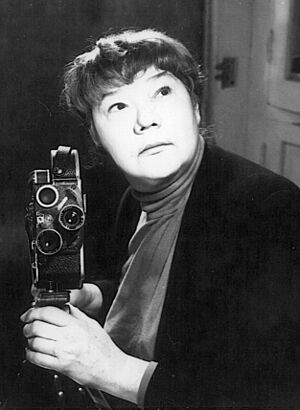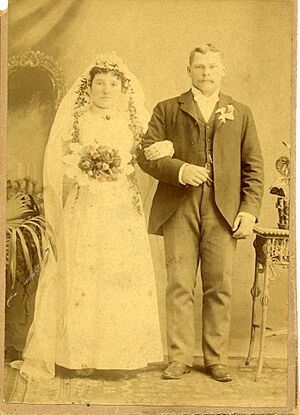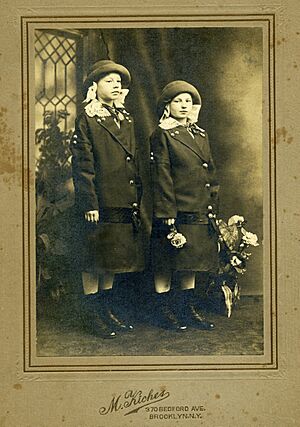Marie Menken facts for kids
Marie Menken (born Marie Menkevicius; May 25, 1909 – December 29, 1970) was an American experimental filmmaker and painter. She was known for her special way of making films, often using a technique called collage. Marie Menken was one of the first filmmakers in New York to use a hand-held camera. She even taught famous artist Andy Warhol how to use it. Her film Glimpse of the Garden was chosen to be saved in the National Film Registry by the Library of Congress. This means it is considered an important part of American film history.
Contents
Early Life and Art Studies
Marie Menkevicius was born in Brooklyn, New York, on May 25, 1909. Her parents were immigrants from Lithuania. Marie studied art at the New York School of Fine and Industrial Arts. She also attended the Art Students League of New York. Here, she became very skilled as a painter. To earn money, she worked as a secretary at the Solomon R. Guggenheim Museum. Later, she received a scholarship from Yaddo, an artists' community. This allowed her to move to upstate New York to continue her art.
Becoming a Filmmaker
Marie Menken once said that she made films simply because she loved the process. She saw filmmaking as a natural next step from her painting. In her paintings, she always looked for ways to show movement and light. She used shiny materials like glitter and glass beads. So, a camera, which captures movement and light, was perfect for her.
In the mid-1940s, Marie and her husband, Willard Maas, started an art group. It was called The Gryphon Group. This group was well-known in the avant-garde art world. Avant-garde means new and experimental art. Around this time, Marie started trying out filmmaking. She found painting on canvas a bit too still.
Her first film, Visual Variations on Noguchi, came out in 1945. It was praised by other experimental artists. For this film, she used a hand-held, hand-cranked 16 mm Bolex camera. This camera helped her create spontaneous and lively films. Noguchi is a film without a clear story. It shows quick shots of sculptures by Isamu Noguchi. It combines these images with unusual music.
Marie and the Gryphon Group made many short experimental films. Marie also experimented with different animation styles. These included collage and stop-motion animation. Her background in painting helped her with these techniques.
One of her most famous films is Notebook (1962). This film is made of short clips she shot between 1940 and 1962. She put them together in a thoughtful way. Marie kept making films that explored different art styles. These included abstract expressionism in Drips in Strips (1963) and pop art in Andy Warhol (1964).
Her Personal Life and Influence
In 1931, Marie met Willard Maas, a literature professor. They married in 1937. Marie and Willard were key members of The Gryphon Group. They were highly respected in the experimental art world. Marie was known for her connections to many leading artists. These included pop artist Andy Warhol and filmmakers Kenneth Anger and Stan Brakhage.
A 2006 documentary film, Notes on Marie Menken, showed that Marie taught Andy Warhol how to use the 16 mm Bolex camera. The film even shows a fun "camera duel" between Marie and Andy. They are seen on a New York City rooftop, dancing and filming each other with their Bolex cameras. Marie later appeared in several of Andy Warhol's films. These include Screen Tests (1964), The Life of Juanita Castro (1965), and Chelsea Girls (1966).
Marie Menken's Unique Style
Marie Menken's painting style used unusual materials. She liked reflective things like glass, glowing paint, and sequins. She did this because she wanted to show movement in her paintings. This desire for movement also led her to filmmaking. Her films often focused on the theme of light.
Her painting background was clear in her later experiments. She used animation, collage, and stop-motion in her films. Movement is a big part of her films. It can be slow and thoughtful, or fast and energetic. Unlike many other experimental films of her time, her early films did not have obvious hidden meanings. Instead, they were meant to be enjoyed just by watching them.
Filmmaker Peter Kubelka said that Marie Menken used film in the best way. He felt she could take viewers to a new world. He believed her films were like explorations into places she had never seen before.
Her Lasting Impact
Marie Menken is celebrated as one of the first filmmakers in New York to use the hand-held camera freely. She let it move and sway around the scene. This was first seen in her film Visual Variations on Noguchi (1945). Marie made this film while helping Japanese-American sculptor Isamu Noguchi. She explained that she was experimenting with special effects for a ballet. She asked Noguchi if she could film in his studio, and he agreed. She found it fun and exciting.
Visual Variations on Noguchi was Marie's way of capturing the "flying spirit of movement" in Noguchi's sculptures. She even danced among the sculptures while filming. This helped her show her own feelings and movements. After seeing the film, filmmaker Stan Brakhage said it changed things for many independent filmmakers. Before Marie, many thought they had to copy smooth Hollywood camera movements. Marie's free, swinging hand-held shots changed that idea for everyone.
Both Stan Brakhage and Jonas Mekas also praised Marie as a "film poetess." For Brakhage, Marie "translated poetic possibilities into the language of cinema." However, some film experts, like Melissa Ragona, argue that this view might limit Marie's true contribution. They believe it makes her work seem only important for understanding Brakhage's place in film history. Marie herself once told Brakhage, "There is enough English poetry to read in a lifetime, why bother with attempts at translations from other languages?"
Melissa Ragona suggests that Marie Menken's films, especially Moon Play and Night Writing, explore painting with light. She used film itself as a canvas. For Ragona, Marie's films were an attempt to push the limits of painting into movement.
In 2006, a documentary film called Notes on Marie Menken was made about her. It featured interviews with people who knew her, like Kenneth Anger and Jonas Mekas. In 2007, her film Glimpse of the Garden (1957) was chosen for preservation in the National Film Registry by the Library of Congress. Her work was also part of the "Women in Abstraction" art show in 2021 at the Centre Pompidou in Paris.
Filmography
Marie Menken made many films. She also worked on films with The Gryphon Group and other artists. This is a list of some of her films:
- Visual Variations on Noguchi (1945)
- Hurry! Hurry! (1957)
- Glimpse of the Garden (1957)
- Dwightiana (1957)
- Eye Music in Red Major (1961)
- Arabesque for Kenneth Anger (1961)
- Notebook (1962)
- Mood Mondrian (1965)
- Andy Warhol (1965)
- Wrestling (1964)
- Moonplay (1964–66)
- Drips in Strips (1961)
- Go Go Go (1962–64)
- Lights (1966)
- Sidewalks (1966)
- Excursion (c. 1968)
- Watts with Eggs (1967)




